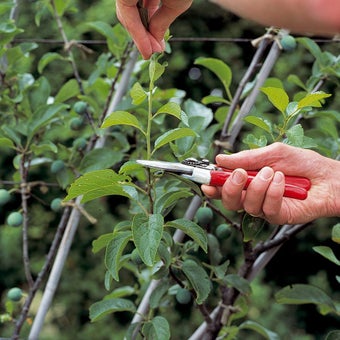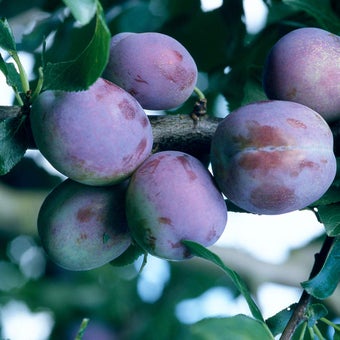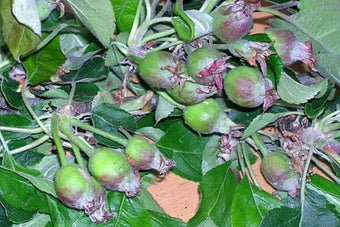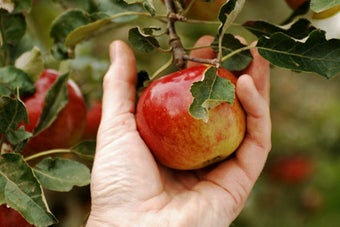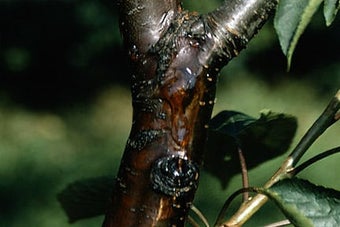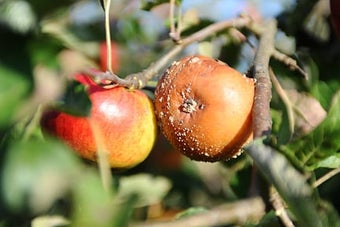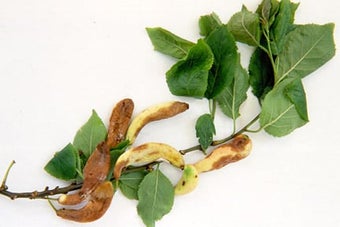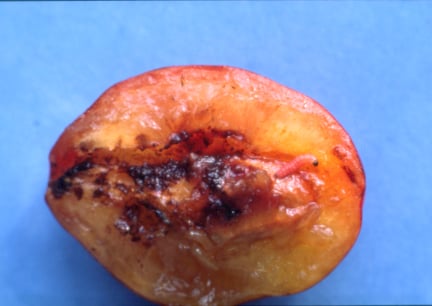
Quick facts
Common name - Plum moth
Scientific name - Grapholita (Cydia) funebrana
Plants affected - Plums, damsons and gages
Main symptoms - Pinkish white caterpillar and excrement pellets inside ripe fruits
Most active - June to September
What is plum moth?
Plum moth is a moth in the family Tortricidae, there are around 400 species of moths in this family in Britain. Most cause no noticeable damage to garden plants.
Plum moth has pinkish caterpillars that feed inside the ripening fruits of plums, damsons and gages.
Symptoms
- Fruits with a caterpillar inside usually ripen early and are often slightly misshapen. This should not be confused with pocket plum, a fungal disease affecting plum fruits. Plum fruits will sometimes produce a clear liquid (gumming), this is thought to be a physiological response to changing water availability and not related to the presence of the moth
- The caterpillar inside the fruit is up to 12 mm long and is pale pink with a brown head
- There will be many light brown excrement pellets near the plum stone where the caterpillar has been feeding
- Affected fruits tend to ripen first, fruits that ripen later on the tree often have a much lower incidence of the caterpillars
A resinous gum around the stone is a physiological disorder and should not be confused with plum moth damage.
Plum sawfly Hoplocampa flava
Plum is a less frequent on plums than plum moth. The larvae tunnel into three or four before going into the soil to pupate. Unlike plum moth whose caterpillar develop in the mature fruit, fruitlets damaged by plum sawfly fall from the tree at an early stagein June. This often goes unnoticed as overall yield is often unaffected.
The plum cultivars ‘Czar’ and ‘Victoria’ seem to be more susceptible than others to plum sawfly.
Management
- Where possible tolerate the loss of some fruit to plum moth, often only a small proportion of fruits are affected. At first levels of the moth can seem high as the first fruit to ripen are those that have been affected by caterpillars
- Encourage predators and other natural enemies in the garden such as birds, hedgehogs and ground beetles
Pheromone traps
- Pheromone traps can be used to trap male moths. They use a synthetic version of volatile chemical (sex-pheromone) produced by female moths to lure in males
- Pheromone traps for plum moth are available from garden shops or from some mail order suppliers biological controls. These consist either of an open-sided box or a plastic container that is hung in the tree in early May. The bottom of the box types has a sticky sheet on which the pheromone pellet is placed. Male plum moths are lured into the trap and get stuck. The plastic container contains water in which the moths drown
- These traps alone rarely control plum moth but monitor moth activity.
- On isolated trees these traps may catch enough males to reduce the females' mating success, resulting in fewer fertile eggs being laid
- Pheromone traps are designed to prevent birds entering the trap and getting caught on the sticky sheet, adding some bird netting will further reduce the risk of birds entering the traps
Biological control
- A mixture of insect pathogenic nematodes (Fruit and Vegetable Protection) is available by mail order from some biological control suppliers, which may provide some control of plum moth. These are microscopic worm-like creatures that enter the bodies of caterpillars and infects them with a fatal bacterial disease. Nematodes have the potential to infect non-target animals, they should therefore be used with care and only when there is a specific problem to treat
- The nematode should be sprayed on the trunk and branches, and also the soil under the branches, in September-October, after the caterpillars have left the fruit
- This treatment gives no protection in the following year against female plum moths flying in from nearby gardens, and so may not be worthwhile in areas where plums are widely grown
Biology
Plum moth usually has one generation a year with adult moths emerging from late May onwards, but mostly in mid-June to mid-July. The newly hatched caterpillars tunnel into the fruits and feed around the stone until late summer. When fully fed, they emerge and overwinter inside silk cocoons spun under loose or other concealed places.
In warm summers, some caterpillars may pupate early and produce a second generation in late summer.
